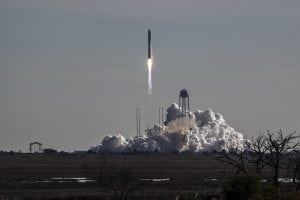Orbital Science’s Launch Raises Awareness of Space Weather-Induced Flight Risks
[Via Satellite 01-09-2014] After a one-day delay, Orbital Sciences’ successful launch of the Antares rocket on Jan. 9, 2014 could be of strong importance to the satellite launch industry, not because of the payload, but for the nature of the delay. The Antares rocket liftoff was originally scheduled for Thursday Jan. 8, 2014, but was delayed, not for cloud cover, temperature or technical reasons, but for space weather. Radiation from an X-class solar flare on Tuesday sent a powerful dispatch of subatomic particles that reached the Earth around the time of the first launch window. The steps Orbital Sciences took in response could become a blueprint for all future launches when it comes to dealing with space weather.
“This is a little bit like global warming,” explained Antonio Elias, executive vice president and chief technical officer of Orbital Sciences in a press teleconference held shortly after the delay announcement. “That is, concern for these issues is relatively recent. A few years ago neither ourselves nor others would really bother to look at space weather as a launch constraint. So this is an enhanced sensitivity that is part of an overall trend to improve reliability.”
Elias mentioned that protons released from the flare had the potential to damage gyroscopes, memory and other electronic components on the rocket. Both the first and second stages of the rocket faced potential interference. He explained that though the first stage was shielded by Earth’s atmosphere, which would attenuate the particles, its components were not radiation-hardened like sections designed for exo-atmospheric conditions. The second stage, despite being designed to withstand greater levels of solar activity, was also at risk because it faced a longer period of exposure. Cygnus, the cargo spacecraft, was not at risk.
“We had received word of an event … that produced a solar array and a proton flux that became problematic for some of our avionics,” said Frank Culbertson, executive vice president and general manager of Orbital’s Advanced Programs Group. “Prior to beginning the countdown we decided that we did not have a path forward that ensured that we would have a safe launch so we decided to scrub for the day, do further analysis, and evaluate both the event itself and our hardware to make sure we could in fact execute the mission.”
Orbital did not want to risk its spacecraft to an unforeseen threat. Without the ability to predict future waves of particles, the company did not feel comfortable with the first launch window. As more details came to light about the solar flare, Orbital moved to err on the side of caution. Reflecting on what may have been an invaluably wise move, Orbital is planning to make sure it can apply this lesson to future launches. And going forward, other launch providers may move to follow suit in keeping a careful watch on the sun’s behavior. Orbital currently does not have any plans to radiation-harden the Antares rocket against future solar activity, but it is looking at ways to be more prepared.
“In terms of what we will do in the future, I don’t think that the frequency of this situation would warrant a modification to the hardware,” said Elias. “However, one thing we will do, and this is a good lesson learned for us, is we will have much more responsive analytical models to answer the question: ‘ok, on the situation we have today, what is the additional risk due to the solar activity?’ so we can answer that question faster.”
This type of precaution could become more common in the launch industry as the implications of space weather are better understood. The successful launch carried out after the sun “calmed down” dramatically lowered the risk of radiation-induced avionics problems.
The launch was Orbital Sciences’ first official resupply mission to the International Space Station (ISS) under NASA’s Commercial Resupply Services (CRS) contract. The Cygnus cargo spacecraft carries 2,780 pounds of supplies to the ISS, which includes vital science experiments, crew provisions, spare parts and other hardware, according to NASA.
